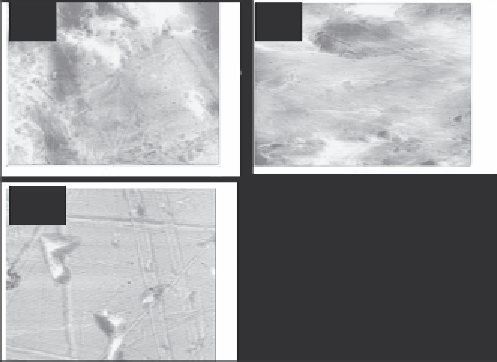Environmental Engineering Reference
In-Depth Information
γS or γP cannot be measured directly but can be calculated by indirect estimation
from the contact angles of diagnostic liquids [60].
Schneider [60] observed that conditioning ilm can considerably alter the acid-base
surface free energy of both hydrophilic and hydrophobic substrata. Bioilms from
seawater and freshwater lakes could not change the γS of PP, Perspex, or germanium,
but 92% of protein coatings and 50% of humic acid ilms altered the γS value. It was
also found that conditioning ilms have a very strong impact on solid-liquid and solid-
particle interfacial tensions and the free energy of adhesion of particles to substrata.
Muthukumar and co-workers [7] in their study on the effect of biofouling on
various polymers and composites immersed for a year in seawater (Bay of Bengal,
South India) found that surface energy, hardness and tensile strength was reduced
whereas surface roughness increased considerably during this period. Surface energy
for all the materials increased, demonstrating that the polymers became relatively
hydrophilic. The increase in the surface energy is attributed to polar groups.
Bioilms not only modify the properties (physical and chemical) of the polymers
but also degrade them. The biodegradation of polymers is normally through the
extracellular enzymes excreted by microorganisms. Some of the microorganisms
reported to degrade polymers are been listed in the
Table 2.3
. Degradation is generally
initiated at the surface of the polymer (
Figure 2.12
).
20.0
(A)
(B)
10.0
10.0
0
0
µ
m
0
10.0
20.0
0
10.0
20.0
(C)
15.0
10.0
5.0
Figure 2.12
Atomic force microscopy
(AFM) images of polymers retrieved from
ocean after one year of deployment (A) LDPE, (B) PP, and (C) PC. Biodeterioration
from ocean currents and wind forces is observed


